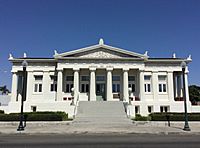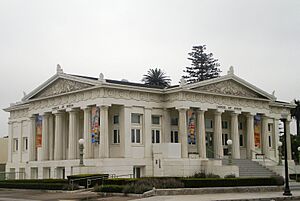Carnegie Art Museum facts for kids

The front facade
|
|
| Established | 1986 |
|---|---|
| Owner | City of Oxnard |
|
Oxnard Public Library
|
|
| Location | 424 S. C St., Oxnard, California |
| Built | 1907 |
| Architect | Franklin P. Burnham |
| Architectural style | Neo-Classical |
| NRHP reference No. | 71000210 |
| Added to NRHP | July 27, 1971 |
The Carnegie Art Museum is a public art museum in Oxnard, California. It is owned by the City of Oxnard. The museum is located in a beautiful building that was once the Oxnard Public Library. This building has a special style called Neo-Classical. It stands next to Oxnard's Plaza Park. The building first opened in 1907 as a library. Later, in 1986, it became an art museum. In July 1971, this building made history. It was the first building in Ventura County to be listed on the National Register of Historic Places. It was also the first Carnegie library in California to get this special honor.
Contents
How the Museum Building Began
The story of this building began in 1904. Oxnard's first mayor, Richard B. Haydock, wrote a letter. He asked Andrew Carnegie for money to build a library. Andrew Carnegie was a very rich businessman who helped build many libraries. In February 1906, Carnegie offered to give $10,000. He said he would donate the money if Oxnard provided the land. The city also had to promise to spend at least $1,000 each year to keep the library running.
Designing a Special Building
By September 1906, construction on the new library was already starting. Mayor Haydock chose a Greek Neo-Classical style for the building. This style includes grand features like Doric columns. A Los Angeles architect named Franklin Burnham designed the building.
Carnegie first offered $10,000 for the library. But the city decided to build something bigger. They wanted a building that could also hold the city's offices and city hall. In July 1906, the city signed a contract for $14,000 to build this dual-purpose building. Carnegie agreed to pay half of the extra cost. In the end, Carnegie gave $12,000, and the city paid $2,000. The main floor was for the library. The basement became Oxnard's city hall.
Early Years as a Library
The library officially opened on May 16, 1907. Just five years later, Oxnard's library was very popular. It had the most books checked out compared to any other city of its size in California. In 1923, the library got even bigger. A new three-story part was added to the building. This allowed the library to hold up to 20,000 books.
From Library to Art Museum
The building served as Oxnard's city hall until 1949. It continued to be the Oxnard Public Library until 1963. In March 1963, the library moved to a new location. For a while, from 1963 to 1975, the building was used by other groups. These included the Oxnard Convention and Visitors Bureau and the Chamber of Commerce.
In 1977, the city received a grant of $133,000. This money was used to restore the historic building. It reopened on August 16, 1980. At that time, it was called the Carnegie Cultural Arts Center. It was home to the Art Club of Oxnard, the Oxnard Historical Society Museum, and part of the public library's collection.
Becoming the Carnegie Art Museum
In 1986, the building officially became the Carnegie Art Museum. The City of Oxnard owns and operates it. In 2002, the museum welcomed 37,000 visitors. It has shown art by many talented Southern California artists. These include Michael Dvortcsak, Joyce Trieman, Frank Romero, and Gronk.
The museum also has its own permanent collection. This collection includes more than 1,500 art and cultural objects. Over 600 of these are paintings, drawings, prints, and photographs. Most of these works are by California artists from the 20th century. Some famous artists in the collection are Arthur Beaumont, Colin Campbell Cooper, Millard Sheets, and Leo Politi.
In 2019, city officials discussed changes for the museum. They considered temporarily closing it. This was part of a plan to help new downtown development begin. The museum was expected to reopen once these new projects were underway.
Historic Recognition
The building received special recognition for its history. In February 1971, the Ventura County Cultural Heritage Board named it a heritage landmark. Just a few months later, in July 1971, the building was added to the National Register of Historic Places. This made it the very first site in Ventura County to receive this important designation.
See also





